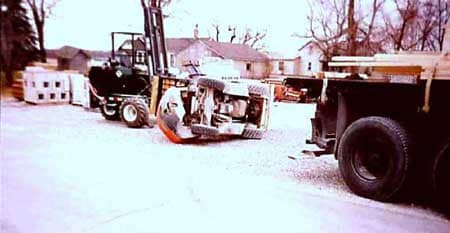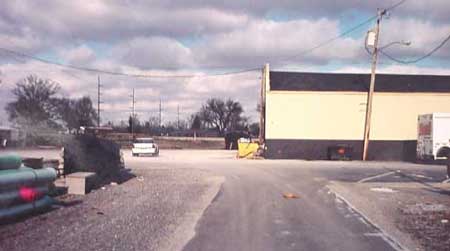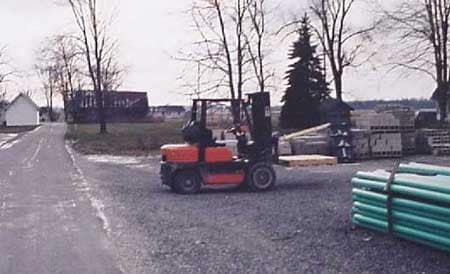Sixteen-Year-Old Laborer At a Building Supply Center Crushed by Forklift That Tipped Over – Ohio
NIOSH In-house FACE Report 2000-09
Summary
On December 22, 1999, a 16-year-old male part-time laborer (the victim) suffered fatal crushing injuries when the forklift he had been operating tipped over. The youth had been operating the forklift to transport an empty pallet from a building supply center warehouse to an outside storage yard. As he turned from an asphalt paved alley onto the gravel-surfaced storage yard, the forklift tipped to the outside of the turn. The youth, who was not wearing the forklift’s seat belt, either jumped or was thrown from the operator’s seat. The forklift tipped over on its side and he was pinned to the ground by the overhead guard (Photo 1). A short time later, one of the building supply center’s co-managers saw the forklift lying on its side in the supply yard and went to check on the victim. He found the victim under the machine and went to another store located across the alley for help. One of the workers in the store, who was an emergency medical technician (EMT), immediately went to the victim to render assistance while a second worker called 911. Emergency rescue personnel arrived within 8 minutes of notification. The victim was transported to a local hospital where he was pronounced dead.
NIOSH investigators concluded that, to help prevent similar occurrences, employers should:
- ensure that forklifts are operated only by authorized employees who have been specifically trained to use safe operating procedures and to recognize the hazards of improper operation
- ensure that operators of sit-down forklifts use the seatbelts provided as part of the operator protection system
- comply with child labor laws prohibiting youth less than 18 years of age from operating power-driven hoisting apparatus such as forklifts.
In addition:
- government agencies should increase efforts to inform the public about child labor laws.
Introduction
On December 22, 1999, a 16-year-old male part-time laborer (the victim) died after the forklift he was operating tipped over and he was pinned to the ground by the overhead guard. On January 5, 2000, the Division of Safety Research, (DSR) was notified of the occurrence by the Ohio Department of Health. On February 8, 2000, a DSR safety engineer met with the investigating Occupational Safety and Health Administration (OSHA) compliance officer and reviewed the investigative file including the county police report and photographs of the incident site. Additional information was obtained through telephone interviews with the employer.
The employer owned a building supply center which had been operating since 1978. The company employed two full-time co-managers and one part-time worker. The company had an unwritten safety policy. Orientations for newly hired employees included training in the company’s hazard communication program, company history, general safety rules, use of protective equipment, and procedures for reporting unsafe conditions and injuries.
The victim had been hired 6 weeks before the incident to work part-time after school hours. He had received orientation on his first day of work along with a hard hat and safety glasses. His duties had consisted of warehouse clean up and maintenance. Although he was not assigned to operate the forklift, he had used it occasionally within the warehouse to move materials while cleaning. This was the company’s first fatality.
Back to Top
Investigation
On December 22, 1999, the co-managers of the building supply center and the victim started work at 7:00 a.m. The victim worked his normal routine, which included assisting with moving materials and cleaning up the warehouse. Around 10:00 a.m. he left the job site with his father to visit a friend who had been hospitalized the night before. Around noon, he returned, ate lunch with one of the co-managers and then continued work. While the co-manager loaded a truck with materials for delivery, the victim continued his cleanup duties. Shortly before 2:00 p.m., the victim told the co-manager that he was going to move an empty pallet with the forklift. The 5100-pound-capacity forklift was in safe operating condition. It was equipped with an overhead guard, seat belt and outside-use tires. The victim boarded the forklift, picked up the empty pallet, and drove toward the outside storage yard, located about 175 feet south of the supply center warehouse (Photo 2 & 3). The incident was unwitnessed; however, evidence suggests that, as the victim approached the storage yard with the pallet raised to the height of the front wheels, he turned the forklift to the right while traveling at or near the vehicle’s top speed. The machine became unstable and tipped toward the outside of the turn as it left the asphalt-paved alley, coming to rest on its left side in the gravel lot. As the machine was tipping over, the victim, who was not wearing the seat belt provided, was either thrown or jumped from the operator’s seat. He was struck by the overhead guard and pinned face down on the ground. A short time later, the co-manager exited the warehouse and looked toward the storage yard. He saw the forklift on its side, went to investigate and found the victim. He immediately went to a store located across the alley from the storage yard and sought help. One of the store employees, who was an EMT, went to the forklift, while another called 911. The co-manager returned to the warehouse and informed the other co-manager of the incident. The two co-managers returned to the site, used a second forklift to raise the forklift off the victim, and placed blocks under its overhead guard to keep it raised. The local emergency rescue service arrived within 8 minutes after the call, removed the victim from under the overhead guard, and transported him to a local hospital where he was pronounced dead.
Back to Top
Cause of Death
The county coroner attributed death to massive crushing injuries.
Recommendations and Discussion
Recommendation #1: Employers should ensure that forklifts are operated only by authorized employees, who have been specifically trained to use safe operating procedures and to recognize the hazards of improper operation.
Discussion: The victim in this incident was 16 years old and had been working for only 6 weeks. According to the employer, he had not been authorized or trained to operate the forklift. Nonetheless, he had used the forklift several times to move materials during his duties of warehouse cleanup while under the observation of one of the co-managers. It is believed that he had not operated the vehicle outside of the warehouse previous to the incident. The only load on the forklift was an empty pallet that was being carried at wheel height. It is not known if the victim attempted to slow the machine during the turn, however, there were two skid marks plainly evident on the asphalt-surfaced alley. The length and path of the skid marks indicate that the right front wheel on the inside of the turn raised off the pavement before the vehicle was on the gravel. The vehicle continued to tip while traveling onto the gravel and came to rest on its left side.
The operating controls of a forklift include brakes, throttle, steering wheel, mast tilt, and hoist controls. At first glance, it would appear that operating a forklift is little more complicated than driving the typical automobile. The steering, braking, and throttle controls are virtually identical. However, the vehicle’s response to control inputs, especially steering, can be decidedly different. Because a forklift is steered by the rear wheels, it tends to pivot around the inside front wheel when negotiating a turn. Also, unlike an automobile in which the driver must continue to apply force to the steering controls to remain in a turn, once a turn is started a forklift may continue in the turn without additional steering input from the operator.[1] Additionally, a forklift’s narrow track and short wheelbase result in the machine having a high center of gravity. These factors make forklifts prone to tipping when sharp turns are attempted at top speeds and may increase the potential for new or inexperienced operators to misjudge the turning capabilities of the machine.
Before being authorized to operate mobile equipment such as forklifts, workers should be trained to recognize the operating characteristics of the vehicle and to understand and demonstrate safe working procedures. This training should include, but not be limited to, recognition of forklift characteristics, safe operating speeds, and the need to remain restrained in the operator’s seat, even during a tip-over. Comprehensive training requirements for general industry are stipulated in Part 29 Code of Federal Regulations, 1910.178, Powered Industrial Trucks.[2] A NIOSH Alert, Preventing Injuries and Deaths of Workers Who Operate or Work Near Forklifts, provides additional recommendations for safe forklift operations.[3]
Recommendation #2: Employers should ensure that forklift operators use the seatbelts provided as part of the operator protection system.
Discussion: The forklift which was involved in this incident was equipped with an overhead guard and a seatbelt for operator restraint. The forklift and overhead guard were undamaged during the tip-over. If the operator had been restrained with a seatbelt, the severity of the injuries may have been significantly reduced.
Recommendation #3: Employers should comply with child labor laws that prohibit youth less than 18 years of age from operating power-driven hoisting apparatus such as forklifts.
Discussion: The Fair Labor Standards Act (FLSA) provides a minimum age of 18 years for nonagricultural occupations which the Secretary of Labor has declared to be particularly hazardous for 16- and 17-year-old persons. The Secretary has issued 17 Hazardous Occupations Orders. Hazardous Order (HO) No. 7 prohibits persons under the age of 18 years from operating power-driven hoisting apparatus including high-lift trucks (i.e., forklifts). The 17 Hazardous Orders are listed and explained by bulletin WH-1330, U.S. Department of Labor, Employment Standards Administration, Wage and Hour Division. [4]
Recommendation #4: Government agencies should increase efforts to inform the public about child labor laws.
Discussion: The employer stated that before the incident, he had not known that youths under 18 years of age were prohibited from operating forklifts. He was, however, aware that persons under 18 years of age were required to obtain a work permit issued by a school administrator before being employed. Researchers have noted that employers, parents, and young workers are often unfamiliar with the work prohibitions and requirements of the FLSA. [5] If the employer had been aware of the prohibition of HO 7, additional precautions may have been implemented to ensure that the victim did not operate the forklift. When work permits are being issued, the distribution of resource materials describing the FLSA and, in particular, the 17 HOs for nonagricultural occupations could increase employers’ knowledge of the requirements protecting youth. This effort could be as basic as printing a list of the 17 HOs on the work permit certificate.
References
- Krieger GR, Montgomery JF [1997]. Accident Prevention Manual for Business and Industry, Engineering & Technology, Eleventh Edition, National Safety Council, Itasca, IL.
- 29 CFR 1910.178 Code of Federal Regulations, U.S. Government Printing Office, Office of Federal Register, 1998.
- CDC [1999]. NIOSH Alert: Preventing Injuries and Deaths of Workers Who Operate or Work Near Forklifts, DHHS (NIOSH) Pub. No. 2000-112.
- DOL [1991]. Child Labor Requirements in Nonagricultural Occupations Under the Fair Labor Standards Act, U. S. Department of Labor, Employment Standards Administration, Wage and Hour Division, WH-1330, revised September 1991.
- NRC [1998]. Protecting Youth at Work: Health, Safety, and Development of Working Adolescents and Children in the United States, National Research Council, et al., Washington, DC: National Press.
Investigator Information
This incident was investigated by Paul H. Moore, Safety Engineer, NIOSH Division of Safety Research, Surveillance and Field Investigations Branch, Fatality Assessment and Control Evaluation Team.
Back to Top
Photographs

|

|

|
|
Photo 3. Building Supply Center – Storage Yard
|
